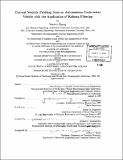Current velocity profiling from an autonomous underwater vehicle with the application of Kalman filtering
Author(s)
Zhang, Yanwu
DownloadFull printable version (10.23Mb)
Other Contributors
Woods Hole Oceanographic Institution.
Advisor
James G. Bellingham and Arthur B. Baggeroer.
Terms of use
Metadata
Show full item recordAbstract
The thesis presents data processing schemes for extracting Earth-referenced current velocity from relative current velocity measurement made by an Acoustic Doppler Current Profiler (ADCP) borne by an Autonomous Underwater Vehicle (AUV). Compared with conventional approaches, current profiling from an AUV platform has advantages including three-dimensional mobility, rapid response, high-level intelligent control, independence from ship motion and weather constraint, and shallow water operation. First, an acausal postprocessing scheme is presented for estimating the AUV's own velocity and removing it from the relative velocity measurement to obtain the true current velocity. Then, a causal scheme for estimating the Earth-referenced current velocity is presented. The causal algorithm is based on an Extended Kalman Filter (EKF) that utilizes the hydrodynamics connecting current velocity to vehicle's motion. In both methods, the raw ADCP measurement is corrected to achieve more accurate current velocity estimate. Field data from the Haro Strait Tidal Front Experiment are processed by both methods. Current velocity estimation results reveal horizontal and vertical velocity structure of the tidal mixing process, and are also consistent with the vehicle's deviated trajectory. The capability of the AUV-borne current profiling system is thus demonstrated.
Description
Thesis (S.M. in Oceanographic Engineering)--Joint Program in Applied Ocean Science and Engineering (Massachusetts Institute of Technology, Dept. of Ocean Engineering; and the Woods Hole Oceanographic Institution); and, (S.M.)--Massachusetts Institute of Technology, Dept. of Electrical Engineering and Computer Science, 1998. Includes bibliographical references (leaves 74-78).
Date issued
1998Department
Joint Program in Applied Ocean Physics and Engineering; Woods Hole Oceanographic Institution; Massachusetts Institute of Technology. Department of Electrical Engineering and Computer Science; Massachusetts Institute of Technology. Department of Ocean EngineeringPublisher
Massachusetts Institute of Technology
Keywords
Joint Program in Applied Ocean Science and Engineering., Ocean Engineering., Woods Hole Oceanographic Institution.